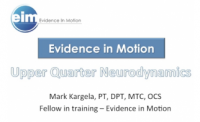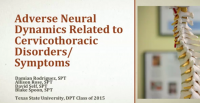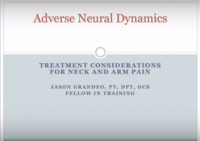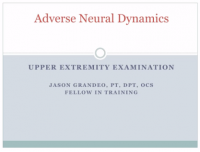Neurodynamics: Difference between revisions
(added video and text) |
No edit summary |
||
| Line 40: | Line 40: | ||
*[[Slump Test|Slump]] (dura) | *[[Slump Test|Slump]] (dura) | ||
*Saphenous | *Saphenous | ||
* | *[[Musculocutaneous Nerve|Musculocutaneous]] | ||
*Axillary | *[[Axillary Nerve Injury|Axillary]] | ||
*Suprascapular<br> | *Suprascapular<br> | ||
| Line 125: | Line 125: | ||
[[Category:Neurodynamics]] | [[Category:Neurodynamics]] | ||
[[Category:Primary Contact]] | [[Category:Primary Contact]] | ||
<references /> | |||
Revision as of 07:30, 16 April 2019
Original Editor - Rachael Lowe
Top Contributors - Evan Thomas, Kim Jackson, Lucinda hampton, Admin, Rachael Lowe, Laura Ritchie, Joshua Samuel, Shaimaa Eldib, Claire Knott and Rucha Gadgil
Neurodynamics[edit | edit source]
Neurodynamics refers to the communication between different parts of the nervous system and to the nervous systems relationship to the musculoskeletal system. It has been shown that the nerves move independently from other tissues.[1] The term Neurodynamics first made an appearance in 1989 and has since been further developed over the last 30 years. Neurodynamics is now seen as an important part of injury assessment and treatment.[1]
Neurodynamics in the sense implied here is the mobilisation of the nervous system as an approach to physical treatment of pain. The treatment and or assessment relies on influencing pain physiology via the mechanical treatment of neural tissues and non-neural structures surrounding the nervous system. This mobilisation activates a range of mechanical and physiological responses in nervous tissues. eg neural sliding, pressurisation, elongation, tension and changes in intraneural microcirculation, axonal transport and nervous impulse movements.[2]
The video below gives a good full description of the principles of neurodynamics
Neural Basics[edit | edit source]
- Neuroanatomy
- Neurophysiology
- Neurobiomechanics
- Neuropathology
Neural Examination[edit | edit source]
- Neural Subjective
- Dermatomes
- Myotomes
- Reflexes
- Neural Palpation
- Romberg’s Test
- Babinski’s Reflex
Neural Provocation Tests[edit | edit source]
- ULTT1 (median nerve bias)
- ULTT2a (median nerve bias, alternate positioning)
- ULTT2b (radial nerve bias)
- ULTT3 (ulnar nerve bias)
- PNF (Lhermitte’s Test)
- SLR (sciatic, tibial, and peroneal nerve biases)
- PKB (femoral nerve bias)
- Slump (dura)
- Saphenous
- Musculocutaneous
- Axillary
- Suprascapular
Conditions with neurodynamic involvement[edit | edit source]
- Ankle Sprain
- Cervical Nerve Root Injury
- Colles Fracture
- Carpel Tunnel Syndrome
- Failed Back Surgery Syndrome
- Hamstring Injury
- Meralgia Paresthetica
- Myelopathy
- Plantarfasciitis
- Post Lumbar Surgery
- Whiplash Associated Disorders
- Thoracic Outlet Syndrome
Presentations[edit | edit source]
 |
Upper Limb Neurodynamics
This presentation, created by Mark Kargela as part of the Evidence In Motion OMPT Fellowship, discusses the upper limb neurodynamics. |
 |
Adverse Neural Dynamics Related to Cervicothoracic Disorders and Symptoms
This presentation, created by Damian Rodriguez, Allison Rose, David Self, Blake Spoon; Texas State DPT Class. |
 |
Adverse Neural Dynamics: Treatment Considerations for Neck and Arm Pain
This presentation, created by Jason Grandeo, as part of the Evidence In Motion OMPT Fellowship, discusses the adverse neurodynamics in the upper quadrant. |
 |
Adverse Neural Dynamics - Upper Extremity Examination
This presentation, created by Jason Grandeo, as part of the Evidence In Motion OMPT Fellowship, reviews indications for using upper-limb neurodynamic tests, describes normal sensory responses for each of the upper limb neurodynamic tests, reviews the validity of the upper limb neurodynamic tests, and describes positive findings with upper limb neurodynamic tests. |
- ↑ 1.0 1.1 Lohkamp M., Herrington L. Small K. Tidy's physiotherapy. London Elsevier 2013
- ↑ Shacklock M. Neurodynamics. Physiotherapy. 1995 Jan 1;81(1):9-16. Available from: https://www.physiotherapyjournal.com/article/S0031-9406(05)67024-1/pdf (last accessed 16.4.2019)
- ↑ Ed Mulligan. CORE principles of neurodynamics. Available from: https://www.youtube.com/watch?v=ct5pOXyO5oc&feature=youtu.be (last accessed 16.4.2019)






